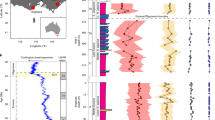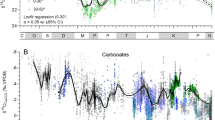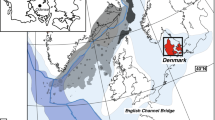Abstract
The early Paleogene (56–48 Myr) provides valuable information about the Earth’s climate system in an equilibrium high \(p_{{\rm{CO}}_2}\) world. High ocean temperatures have been reconstructed for this greenhouse period, but land temperature estimates have been cooler than expected. This mismatch between marine and terrestrial temperatures has been difficult to reconcile. Here we present terrestrial temperature estimates from a newly calibrated branched glycerol dialkyl glycerol tetraether-based palaeothermometer in ancient lignites (fossilized peat). Our results suggest early Palaeogene mid-latitude mean annual air temperatures of 23–29 °C (with an uncertainty of ± 4.7 °C), 5–10 °C higher than most previous estimates. The identification of archaeal biomarkers in these same lignites, previously observed only in thermophiles and hyperthermophilic settings, support these high temperature estimates. These mid-latitude terrestrial temperature estimates are consistent with reconstructed ocean temperatures and indicate that the terrestrial realm was much warmer during the early Palaeogene than previously thought.
This is a preview of subscription content, access via your institution
Access options
Access Nature and 54 other Nature Portfolio journals
Get Nature+, our best-value online-access subscription
$29.99 / 30 days
cancel any time
Subscribe to this journal
Receive 12 print issues and online access
$259.00 per year
only $21.58 per issue
Buy this article
- Purchase on Springer Link
- Instant access to full article PDF
Prices may be subject to local taxes which are calculated during checkout



Similar content being viewed by others
References
Anagnostou, E. et al. Changing atmospheric CO2 concentration was the primary driver of early Cenozoic climate. Nature 533, 380–384 (2016).
Beerling, D. J. & Royer, D. L. Convergent Cenozoic CO2 history. Nat. Geosci. 4, 418–420 (2011).
Lunt, D. J. et al. A model–data comparison for a multi-model ensemble of early Eocene atmosphere–ocean simulations: EoMIP. Clim. Past 8, 1717–1736 (2012).
IPCC Climate Change 2013: The Physical Science Basis (eds Stocker, T. F. et al.) (Cambridge Univ. Press, Cambridge, 2013).
White, A. F. & Blum, A. E. Effects of climate on chemical weathering in watersheds. Geochim. Cosmochim. Acta 59, 1729–1747 (1995).
Yvon-Durocher, G. et al. Methane fluxes show consistent temperature dependence across microbial to ecosystem scales. Nature 507, 488–491 (2014).
Schouten, S., Hopmans, E. C., Schefuss, E. & Sinninghe Damsté, J. S. Distributional variations in marine crenarchaeotal membrane lipids: a new tool for reconstructing ancient sea water temperatures? Earth Planet. Sci. Lett. 204, 265–274 (2002).
Bijl, P. K. et al. Early Palaeogene temperature evolution of the southwest Pacific Ocean. Nature 461, 776–779 (2009).
Evans, D. et al. Eocene greenhouse climate revealed by coupled clumped isotope-Mg/Ca thermometry. Proc. Natl Acad. Sci. USA 115, 1174–1179 (2018).
Huber, M. & Caballero, R. The early Eocene equable climate problem revisited. Clim. Past 7, 603–633 (2011).
Ho, S. L. & Laepple, T. Flat meridional temperature gradient in the early Eocene in the subsurface rather than surface ocean. Nat. Geosci. 9, 606–610 (2016).
Evans, D. & Müller, W. Deep time foraminifera Mg/Ca paleothermometry: nonlinear correction for secular change in seawater Mg/Ca. Paleoceanography 27, PA4205 (2012).
Eberle, J. J. et al. Seasonal variability in Arctic temperatures during early Eocene time. Earth Planet. Sci. Lett. 296, 481–486 (2010).
Hollis, C. J. et al. Early Paleogene temperature history of the Southwest Pacific Ocean: reconciling proxies and models. Earth Planet. Sci. Lett. 349–350, 53–66 (2012).
Kiehl, J. T. & Shields, C. A. Sensitivity of the Palaeocene–Eocene Thermal Maximum climate to cloud properties. Phil. Trans. R. Soc. A 371, 0093 (2013).
Sagoo, N., Valdes, P., Flecker, R. & Gregoire, L. J. The Early Eocene equable climate problem: can perturbations of climate model parameters identify possible solutions? Phil. Trans. R. Soc. A 371, 0123 (2013).
Yang, J., Spicer, R. A., Spicer, T. E. V. & Li, C.-S. ‘CLAMP Online’: a new web-based palaeoclimate tool and its application to the terrestrial Paleogene and Neogene of North America. Palaeobiodivers. Palaeoenviron. 91, 163–183 (2011).
Inglis, G. N. et al. Mid-latitude continental temperatures through the early Eocene in western Europe. Earth Planet. Sci. Lett. 460, 86–96 (2017).
De Jonge, C. et al. Occurrence and abundance of 6-methyl branched glycerol dialkyl glycerol tetraethers in soils: implications for palaeoclimate reconstruction. Geochim. Cosmochim. Acta 141, 97–112 (2014).
Weijers, J. W. H., Schouten, S., van den Donker, J. C., Hopmans, E. C. & Sinninghe Damsté, J. S. Environmental controls on bacterial tetraether membrane lipid distribution in soils. Geochim. Cosmochim. Acta 71, 703–713 (2007).
Pancost, R. D. et al. Early Paleogene evolution of terrestrial climate in the SW Pacific, Southern New Zealand. Geochem. Geophys. Geosyst. 14, 5413–5429 (2013).
Naafs, B. D. A. et al. Introducing global peat-specific temperature and pH calibrations based on brGDGT bacterial lipids. Geochim. Cosmochim. Acta 208, 285–301 (2017).
Schouten, S., Hopmans, E. C. & Sinninghe Damsté, J. S. The organic geochemistry of glycerol dialkyl glycerol tetraether lipids: a review. Org. Geochem. 54, 19–61 (2013).
Fry, J. C. et al. Prokaryotic populations and activities in an interbedded coal deposit, including a previously deeply buried section (1.6–2.3 km) above ~150 Ma basement rock. Geomicrobiol. J. 26, 163–178 (2009).
Inglis, G. N. et al. Ecological and biogeochemical change in an early Paleogene peat-forming environment: linking biomarkers and palynology. Palaeogeogr. Palaeoclimatol. Palaeoecol. 438, 245–255 (2015).
Kowalski, E. A. & Dilcher, D. L. Warmer paleotemperatures for terrestrial ecosystems. Proc. Natl Acad. Sci. USA 100, 167–170 (2003).
Hyland, E., Sheldon, N. D. & Fan, M. Terrestrial paleoenvironmental reconstructions indicate transient peak warming during the early Eocene climatic optimum. Geol. Soc. Am. Bull. 125, 1338–1348 (2013).
Weijers, J. W. H., Schouten, S., Sluijs, A., Brinkhuis, H. & Sinninghe Damsté, J. S. Warm arctic continents during the Palaeocene–Eocene thermal maximum. Earth Planet. Sci. Lett. 261, 230–238 (2007).
Suan, G. et al. Subtropical climate conditions and mangrove growth in Arctic Siberia during the early Eocene. Geology 45, 539–542 (2017).
Sluijs, A. et al. Warm and wet conditions in the Arctic region during Eocene Thermal Maximum 2. Nat. Geosci. 2, 777–780 (2009).
Eberle, J. J. & Greenwood, D. R. Life at the top of the greenhouse Eocene world—a review of the Eocene flora and vertebrate fauna from Canada’s High Arctic. Geol. Soc. Am. Bull. 124, 3–23 (2012).
Dawson, M. R., West, R. M., Langston, W. & Hutchison, J. H. Paleogene terrestrial vertebrates: northernmost occurrence, Ellesmere Island, Canada. Science 192, 781 (1976).
Snell, K. E. et al. Hot summers in the Bighorn Basin during the early Paleogene. Geology 41, 55–58 (2013).
Fricke, H. C. & Wing, S. L. Oxygen isotope and paleobotanical estimates of temperature and δ18O–latitude gradients over North America during the early Eocene. Am. J. Sci. 304, 612–635 (2004).
Grein, M., Konrad, W., Wilde, V., Utescher, T. & Roth-Nebelsick, A. Reconstruction of atmospheric CO2 during the early middle Eocene by application of a gas exchange model to fossil plants from the Messel Formation, Germany. Palaeogeogr. Palaeoclimatol. Palaeoecol. 309, 383–391 (2011).
Sluijs, A. et al. Environmental precursors to rapid light carbon injection at the Palaeocene/Eocene boundary. Nature 450, 1218–1221 (2007).
Pross, J. et al. Persistent near-tropical warmth on the Antarctic continent during the early Eocene epoch. Nature 488, 73–77 (2012).
Crouch, E. M. & Visscher, H. Terrestrial vegetation record across the initial Eocene thermal maximum at the Tawanui marine section, New Zealand. Geol. Soc. Am. 369, 351–363 (2003).
Spicer, R. A. et al. Asian Eocene monsoons as revealed by leaf architectural signatures. Earth Planet. Sci. Lett. 449, 61–68 (2016).
Sinninghe Damsté, J. S. Spatial heterogeneity of sources of branched tetraethers in shelf systems: the geochemistry of tetraethers in the Berau River delta (Kalimantan, Indonesia). Geochim. Cosmochim. Acta 186, 13–31 (2016).
Winguth, A., Shellito, C., Shields, C. & Winguth, C. Climate response at the Paleocene–Eocene thermal maximum to greenhouse gas forcing—a model study with CCSM3. J. Clim. 23, 2562–2584 (2009).
Lunt, D. J. et al. CO2-driven ocean circulation changes as an amplifier of Paleocene–Eocene thermal maximum hydrate destabilization. Geology 38, 875–878 (2010).
Heinemann, M., Jungclaus, J. H. & Marotzke, J. Warm Paleocene/Eocene climate as simulated in ECHAM5/MPI-OM. Clim. Past 5, 785–802 (2009).
Roberts, C. D., LeGrande, A. N. & Tripati, A. K. Climate sensitivity to Arctic seaway restriction during the early Paleogene. Earth Planet. Sci. Lett. 286, 576–585 (2009).
Creech, J. B., Baker, J. A., Hollis, C. J., Morgans, H. E. G. & Smith, E. G. C. Eocene sea temperatures for the mid-latitude southwest Pacific from Mg/Ca ratios in planktonic and benthic foraminifera. Earth Planet. Sci. Lett. 299, 483–495 (2010).
Douglas, P. M. J. et al. Pronounced zonal heterogeneity in Eocene southern high-latitude sea surface temperatures. Proc. Natl Acad. Sci. USA 111, 6582–6587 (2014).
Cao, M., Gregson, K. & Marshall, S. Global methane emission from wetlands and its sensitivity to climate change. Atmos. Environ. 32, 3293–3299 (1998).
Beerling, D. J., Fox, A., Stevenson, D. S. & Valdes, P. J. Enhanced chemistry–climate feedbacks in past greenhouse worlds. Proc. Natl Acad. Sci. USA 108, 9770–9775 (2011).
Sloan, L. C., Walker, J. C. G., Moore, T. C., Rea, D. K. & Zachos, J. C. Possible methane-induced polar warming in the early Eocene. Nature 357, 320–322 (1992).
Pancost, R. D. et al. Increased terrestrial methane cycling at the Palaeocene–Eocene thermal maximum. Nature 449, 332–335 (2007).
Hopmans, E. C., Schouten, S. & Sinninghe Damsté, J. S. The effect of improved chromatography on GDGT-based palaeoproxies. Org. Geochem. 93, 1–6 (2016).
Weijers, J. W. H., Schouten, S., van der Linden, M., van Geel, B. & Sinninghe Damsté, J. S. Water table related variations in the abundance of intact archaeal membrane lipids in a Swedish peat bog. FEMS Microbiol. Lett. 239, 51–56 (2004).
Acknowledgements
The research that led to these results has received funding from the European Research Council under the European Union’s Seventh Framework Programme (FP/2007-2013)/ERC Grant Agreement no. 340923 (T-GRES, awarded to R.D.P.). R.D.P. also acknowledges the Royal Society Wolfson Research Merit Award. M.R. received support from an Agouron Institute geobiology postdoctoral research fellowship. E.M.K. was supported by the New Zealand government-funded Global Change through Time Programme at GNS Science. We acknowledge the T-GRES peat database collaboration, which consists of B.D.A. Naafs, G.N. Inglis, Y. Zheng, M.J. Amesbury, H. Biester, R. Bindler, J. Blewett, M.A. Burrows, D. del Castillo Torres, F.M. Chambers, A.D. Cohen, R.P. Evershed, S.J. Feakins, M. Gałka, A. Gallego-Sala, L. Gandois, D.M. Gray, P.G. Hatcher, E.N. Honorio Coronado, P.D.M. Hughes, A. Huguet, M. Könönen, F. Laggoun-Défarge, O. Lähteenoja, M. Lamentowicz, R. Marchant, E. McClymont, X. Pontevedra-Pombal, C. Ponton, A. Pourmand, A.M. Rizzuti, L. Rochefort, J. Schellekens, F. De Vleeschouwer and R.D. Pancost. In addition, the Cobham and Schöningen samples were originally collected for other research projects and we particularly thank V. Wilde and W. Riegel (Schöningen) and J. Hooker (Cobham) for their extensive personal support during the sample collection. The Schöningen samples were collected with logistical and financial support that includes NERC grants nos NE/J008656/1 to M.E.C. and NE/J008591/1 to R.D.P. and we thank Helmstedter Revier of MIBRAG and previous owners for access to the mine, which has now closed. Alfred McAlpine, AMEC and Channel Tunnel Rail Link are thanked for providing access to the Cobham site. We thank A. Farnsworth for calculating the palaeolatitudes for all locations.
Author information
Authors and Affiliations
Contributions
B.D.A.N., M.E.C. and R.D.P. designed the project. B.D.A.N. analysed all the samples in the modern peat database for isoGDGTs and wrote the manuscript with contributions from all the authors. M.R. analysed the Indian and Otaio lignite samples for GDGTs and G.N.I. analysed the Cobham and Schöningen lignite samples for GDGTs. B.D.A.N., M.E.C. and E.M.K. developed the database of early Palaeogene terrestrial palaeoclimate proxies. M.E.C. (Cobham and Schöningen samples), E.M.K. (Otaio samples) and P.K.S. (Indian samples) provided age models and the stratigraphic context of the lignites. O.L. provided the modern tropical peat samples from Peru.
Corresponding author
Ethics declarations
Competing interests
The authors declare no competing interests.
Additional information
Publisher’s note: Springer Nature remains neutral with regard to jurisdictional claims in published maps and institutional affiliations.
Supplementary information
Rights and permissions
About this article
Cite this article
Naafs, B.D.A., Rohrssen, M., Inglis, G.N. et al. High temperatures in the terrestrial mid-latitudes during the early Palaeogene. Nature Geosci 11, 766–771 (2018). https://doi.org/10.1038/s41561-018-0199-0
Received:
Accepted:
Published:
Issue Date:
DOI: https://doi.org/10.1038/s41561-018-0199-0
This article is cited by
-
Comparison of Pretreatment Methods for Organic-matter Removal and their Effects on the Hydrogen Isotope (δ2H) Composition of Kaolinite
Clays and Clay Minerals (2022)
-
Eocene to Oligocene terrestrial Southern Hemisphere cooling caused by declining pCO2
Nature Geoscience (2021)
-
Spatial pattern of super-greenhouse warmth controlled by elevated specific humidity
Nature Geoscience (2020)
-
Comparative genomics and transcriptomics analysis reveals evolution patterns of selection in the Salix phylogeny
BMC Genomics (2019)



